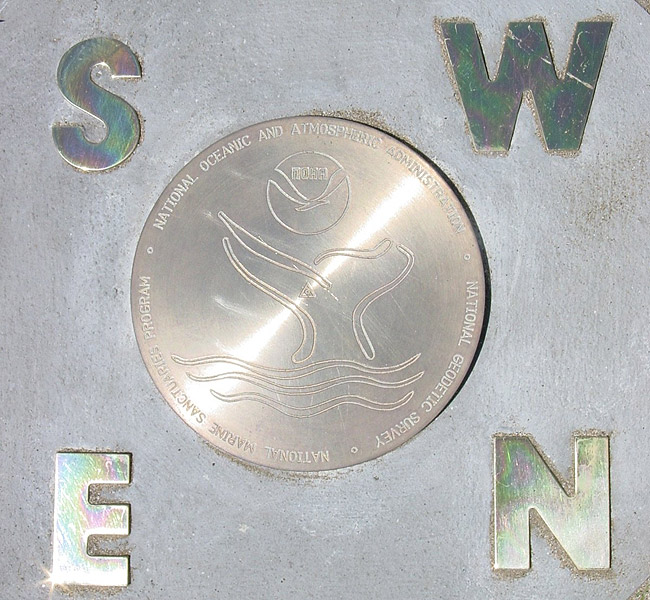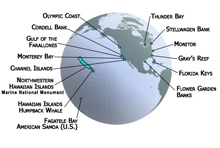 Lewis and Clark Corps of Discovery Bicentennial
Lewis and Clark Corps of Discovery Bicentennial 2002 Winter Olympics – Salt Lake City
2002 Winter Olympics – Salt Lake City U.S. Center of Population: 2000
U.S. Center of Population: 2000 NOAA Heritage Trail: The Calais Observatory
NOAA Heritage Trail: The Calais Observatory Ocean in View! The Nation's Newest Nickel
Ocean in View! The Nation's Newest Nickel 100th Anniversary of the First Flight
100th Anniversary of the First Flight 50th Anniversary of the Fredericksburg Geomagnetic Center
50th Anniversary of the Fredericksburg Geomagnetic Center Fagatele Bay National Marine Sanctuary, American Samoa
Fagatele Bay National Marine Sanctuary, American Samoa Pago Pago Harbor, American Samoa
Pago Pago Harbor, American Samoa Kilauea Point National Wildlife Refuge, Hawaii
Kilauea Point National Wildlife Refuge, Hawaii Hassler Park
Hassler Park 100th Anniversary of the U.S. Forest Service
100th Anniversary of the U.S. Forest Service National Estuarine Research Reserve System
National Estuarine Research Reserve System Hawaiian Islands Humpback Whale National Marine Sanctuary
Hawaiian Islands Humpback Whale National Marine Sanctuary
Hawaiian Islands Humpback Whale National Marine Sanctuary
This commemorative mark was dedicated on July 30, 2004, at the Hawaiian Islands Humpback Whale National Marine Sanctuary headquarters in Kihei, Maui, Hawai`i. This mark is one of a series to be set at the nation's marine sanctuaries.

This mark was dedicated on July 30, 2004, at the Hawaiian Islands Humpback Whale National Marine Sanctuary headquarters in Kihei, Maui, Hawai`i. The mark was placed at the sanctuary headquarters to enhance public understanding of the National Spatial Reference System and related global positioning system (GPS) technologies. The mark will assist coastal users such as researchers, boaters, hikers, and surveyors in testing the accuracy of their GPS equipment.
This commemorative mark is one of a series to be set at national marine sanctuaries. NOAA's National Marine Sanctuary Program manages and protects specially designated areas of the nation's oceans and Great Lakes for their habitats; ecological value; threatened and endangered species; and historic, archeological, recreational, and esthetic resources.
Historic Reference

Areas managed by the National Marine Sanctuary Program range in size from one-quarter square mile in Fagatele Bay, American Samoa, to more than 135,000 square miles in the Northwestern Hawaiian Islands, the largest marine protected area in the world. Together these sanctuaries encompass over 150,000 square miles of waters and marine habitats.
In 1972, exactly 100 years after the first national park was created, the nation made a similar commitment to preserving its marine treasures by establishing the National Marine Sanctuary Program. Since then, 13 national marine sanctuaries and one marine national monument, representing a wide variety of ocean environments, have been established.
Congress, in consultation with the State of Hawai`i, designated the Hawaiian Islands Humpback Whale National Marine Sanctuary on November 4, 1992. The sanctuary's primary focus is humpback whales, which come to sanctuary waters to breed, calve, and nurse their young before returning north to the colder waters of the Bering Sea. However, Hawaii also provides harbor for fin, minke, pygmy, false killer, and right whales; and the warm waters teem with many species of dolphin including bottlenose, spinner, striped, and rough-toothed. Sea turtles, sharks, monk seals, a thriving coral reef ecosystem, and diverse populations of seabirds are other important elements of Hawaii's marine environment.
Today, the waters around the main Hawaiian Islands of Kauai, Oahu, Hawaii, Maui, Molokai, Lanai, and Kaho'olawe constitute one of the world's most important North Pacific humpback whale (Megaptera novaeangliae) habitats and the only place in the U.S. where humpbacks reproduce. Scientists estimate that two-thirds of the entire North Pacific humpback whale population (approximately 4,000-5,000 whales) migrates to Hawaiian waters to engage in breeding, calving, and nursing activities.
- Designation: Not yet in database
- PID: Not yet in database
- Year: 2004
- Location: Hawaiian Islands Humpback Whale National Marine Sanctuary, Kihei, Maui
- Latitude/Longitude: Not yet in database
Related Web Sites:
NOAA's National Marine Sanctuary Program
